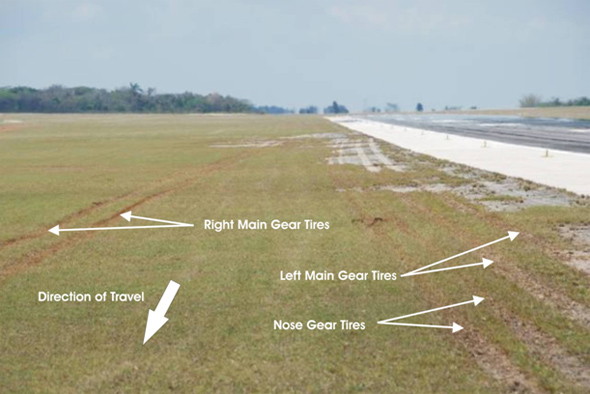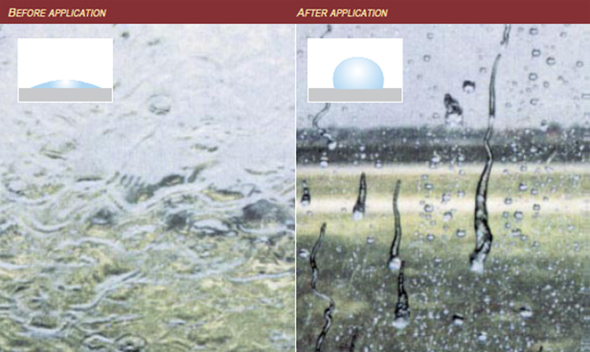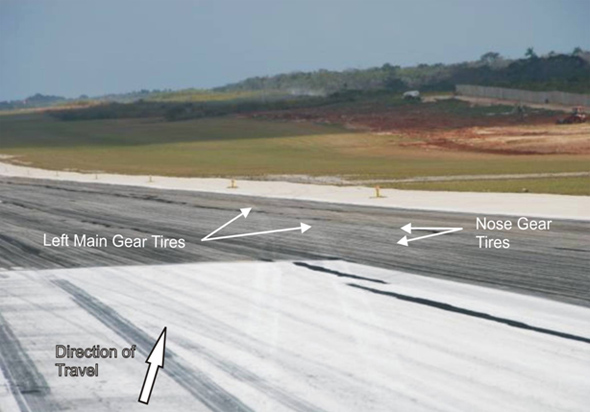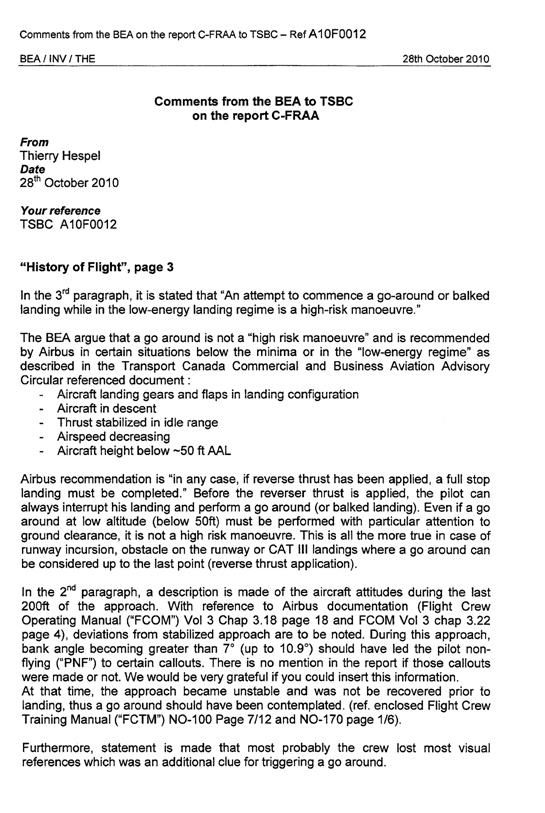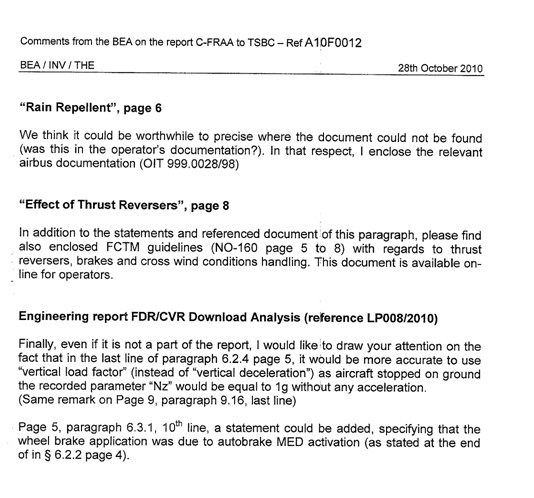Runway Excursion
Skyservice Airlines Inc.
Airbus A320-232, C-FRAA
Varadero, Cuba
The Transportation Safety Board of Canada (TSB) investigated this occurrence for the purpose of advancing transportation safety. It is not the function of the Board to assign fault or determine civil or criminal liability. This report is not created for use in the context of legal, disciplinary or other proceedings. See Ownership and use of content. Masculine pronouns and position titles may be used to signify all genders to comply with the Canadian Transportation Accident Investigation and Safety Board Act (S.C. 1989, c. 3).
Summary
The Skyservice Airlines Inc. Airbus A320-232 (serial number 1141, registration C-FRAA) departed from Lester B. Pearson International Airport in Toronto, Ontario, for Juan Gualberto Gomez International Airport in Varadero, Cuba. At 2149 Eastern Standard Time, shortly after touching down in heavy rain during the hours of darkness, the aircraft drifted off the runway to the right. After travelling approximately 1745 feet parallel to the runway, the crew was able to bring the aircraft back onto the runway. There were no injuries to the 179 passengers and 7 crew members. There was no fire and no evacuation was necessary. The aircraft sustained minor damage.
Factual information
History of Flight
The Skyservice Airlines Inc. (Skyservice) Airbus A320-232 (A320) was being operated as flight SSV5044. The aircraft departed from Toronto Lester B. Pearson International Airport at 1823 Footnote 1 for Juan Gualberto Gomez International Airport (MUVR) in Varadero, Cuba. The flight en route was uneventful.
Before receiving descent clearance, the captain, who was the pilot flying (PF), briefed for the VOR ILS Footnote 2 Runway 06 approach at MUVR. The captain initiated the descent 160 nautical miles (nm) from MUVR.
Once under the control of the Havana area control centre (ACC), the flight was cleared to fly direct to the eight DME Footnote 3 final approach fix (FAF) for the VOR ILS Runway 06 approach. The flight was following a Boeing 737 (B737), that was approximately 20 nm ahead on the same approach to MUVR. Except for a few rain showers to the left of its track, there was no significant weather showing on the aircraft's weather radar. Approximately 3 minutes later, the ACC advised the crew that the visibility at the airport was 2 kilometres in rain. The crew acknowledged this information and then discussed missed approach scenarios. Approximately 19 minutes before SSV5044's arrival at MUVR, the reported visibility decreased to 1000 metres in heavy rain. That information was not passed on to the crew of SSV5044.
As the aircraft turned onto final approach, the preceding B737, which was now 7 nm ahead, executed a go around. When the flight crew of the B737 called the ACC to advise them of the go around, they did not provide a reason or offer a pilot report (PIREP). In addition, no information was requested by or issued to the crew of SSV5044 regarding the reason for the go around of the preceding aircraft. The crew of SSV5044 reviewed the approach minimums and its fuel situation to ensure the quantity was sufficient for a possible missed approach and flight to its alternate airport.
Heavier precipitation was visible on the weather radar as the aircraft intercepted the glideslope. The aircraft descended below 1000 feet above ground level (agl) in a stable approach. The runway environment came into sight at approximately 900 feet agl. The crew configured the aircraft and completed the landing checklist. With the runway in sight, the crew contacted MUVR tower whereupon it received its landing clearance. The wind was reported as 060° magnetic (M) at 12 knots. Throughout the last 400 feet of the approach, the flight data recorder (FDR) data indicated the wind was at 045°M , at 15 knots, and decreased in speed to 10 knots at touchdown.
As the aircraft descended through approximately 500 feet agl the rain increased in intensity. Just prior to reaching the decision height (DH) of 200 feet agl, the autopilot was disconnected. At the DH, the aircraft was established on both the glideslope and the localizer. FDR data indicates that the approach was stable.
Shortly after the autopilot was disconnected, the aircraft started to descend below the glideslope and drift slightly to the right. The captain applied nose-up elevator and left aileron. The aircraft then quickly passed left of the runway centreline and continued to descend below the glideslope. The captain corrected with some right aileron control input which was maintained until just before touchdown. The aircraft crossed the threshold at approximately 20 feet agl with the right bank angle increasing through 6°. In the flare, at 5 feet agl, the right bank angle reached a maximum of 10.9°.
Just prior to touchdown, the precipitation intensified and the visibility decreased to the point where the crew lost most visual references. At this point, the aircraft was in a low-energy state. An attempt to commence a go-around or balked landing while in the low-energy landing regime is a high-risk manoeuvre. Footnote 4 At that point, given the aircraft configuration, its low energy state and position relative to the runway, a go-around was rejected as an option and the captain committed to landing the aircraft.
The runway surface was covered with standing water. At approximately 640 feet from the threshold, the aircraft touched down left of the centreline with approximately 7° of right bank. The aircraft drifted to the right, through the centreline, toward the edge of the runway.
On touchdown, the spoilers deployed automatically and the thrust reversers were selected. As the aircraft tracked toward the right edge of the runway, the captain applied left rudder but the aircraft continued to drift to the right. The aircraft exited the runway approximately 1700 feet from the threshold at a speed of approximately 130 knots.
The aircraft then began tracking parallel to the runway with a 10° left crab for approximately 1745 feet. During that time, the engines began developing reverse thrust. At approximately 4300 feet from the threshold and at a speed of 40 knots, the aircraft re-entered the runway (see Photo 1).
The crew ascertained that the aircraft was fit to taxi to the gate and did so. The crew also attempted to inform the control tower of the excursion but the airport controller's reaction suggests that the controller did not hear or understand the communication at that time. One unidentified pilot from another aircraft contacted the control tower to ask if there were any thunderstorms in the area and talked to the captain of SSV5044. The unidentified pilot was told about the possible excursion and another unidentified aircraft flight crew also acknowledged the transmission. It was only after the aircraft was shutdown at the gate that the crew was able to confirm that the proper authority would be advised of the excursion and that a runway inspection would be conducted. After shutdown, the crew also called the company to report its arrival time and the runway excursion.
Weather
A few thunderstorms were encountered in the descent toward MUVR. The forecast for MUVR at the time of arrival indicated some thunderstorm activity and rain showers, then, after the rain, broken clouds at 1500 feet agl. Forecast weather at the alternate airport was visual flight conditions and light winds.
The weather observation at MUVR, 19 minutes before arrival was as follows:
Wind 030° True (T) at 8 knots variable from 340 to 070°T, visibility 1000 meters in heavy rain, broken ceiling at 1600 feet agl, temperature 22°C , dew point 20°C , altimeter 1017 millibars.
The weather observed 7 minutes after landing was:
Wind 050°T at 12 knots variable from 010 to 070°T, visibility 1000 meters in heavy rain, broken ceiling at 1800 feet agl, temperature 21°C , altimeter 1017 millibars.
Crew Information
Records indicate that the pilots were certified and qualified for the flight in accordance with existing regulations.
The captain held a Canadian Airline Transport Pilot licence with a Group 1 instrument rating valid until January 2012. He had accumulated 19 574 hours, with more than 13 000 hours on large transport aircraft including over 7000 hours as captain on the A320. He had been working for Skyservice since November 2001. On 28 and 29 January 2010, the captain had been off duty and on 30 January 2010, he operated a return flight from Toronto to Puerto Plata, Dominican Republic, arriving back in Toronto at 0150.
The first officer held a Canadian Airline Transport Pilot licence with a Group 1 instrument rating valid until November 2010. He had accumulated approximately 6900 hours, with more than 5500 hours on large transport aircraft including over 3250 hours as first officer on the A320. He had been working for Skyservice since March 2001. On 28 January 2010, the first officer operated a return flight from Toronto to Cancun, Mexico, arriving back in Toronto at 0148. On 29 January 2010, he was off duty and on 30 January 2010, he was on reserve duty from 1200 to 2400.
Both the captain and the first officer were well rested prior to the flight. Fatigue was not considered as a contributing factor in this accident.
Aircraft
Records indicate that the aircraft was certified, equipped, and maintained in accordance with existing regulations and approved procedures.
The weight and centre of gravity were within the prescribed limits at the time of the accident. There was sufficient fuel on board to complete the flight to destination, Varadero (MUVR), and alternate, Cayo Coco, Cuba. The aircraft was equipped with a flight data recorder (FDR) and a cockpit voice recorder (CVR) that were recovered and provided useful information to the investigation.
Aircraft Damage
The ground along the runway edge consists of hard-packed grass with some gravel patches and has a slight down slope for drainage. There was minor damage to the aircraft caused by contact with runway edge lights, objects, and debris. Damage was limited to:
- the tires, but no reverted rubber hydroplaning Footnote 5 damage was found;
- engine fan blades and some of the acoustic and ice impact panels on the right engine;
- one of the flap track fairings; and
- the right hand air conditioning pack.
Rain Repellent
All Airbus aircraft are equipped with a rain repellent system. When heavy rain is encountered, the flight crew activates the system by depressing a switch on the overhead panel. The system delivers a calibrated quantity of rain repellent fluid which is dispersed evenly onto the windshield outer surfaces. The repellent fluid is fast-acting and long-lasting with no build-up or distortion and restores visibility in seconds. The surface tension on the windshield is temporarily modified and, combined with airflow, prevents water droplets from adhering to the windshield (see Photo 2).
In January 1996, the original fluid was banned from production, import and export for environmental reasons. In 1998, a replacement fluid which complies with all existing environmental regulations became available to the aviation industry. Only a minor modification of existing rain repellent systems is required to make use of the new fluid.
At Skyservice, the rain repellent capability of its Airbus fleet had only been put back into operational service in the fall of 2008. The crew of SSV5044 was unaware that the capability had been put back into service. No official Skyservice memorandum, or other formal means of communication from the company, informing flight crews of the re-activation of the rain repellent systems could be found.
Hydroplaning
Hydroplaning occurs when aircraft tires are separated from the pavement surface by a thin film of fluid that significantly reduces friction. During hydroplaning, a build-up of hydrodynamic pressure between the tire and flooded surface occurs at a certain speed. Footnote 7 When this hydrodynamic pressure exceeds the tire-pavement bearing pressure, a wedge of water penetrates the tire contact area and the tire footprint is partially or totally detached from the pavement surface. Under total dynamic hydroplaning conditions, tire friction capability is reduced to near zero because of the inability of the fluid to support significant shear forces.
Generally, three types of aircraft hydroplaning occur: Footnote 8
- Viscous hydroplaning occurs at a relatively low speed on a wet runway. The friction between the tire and runway is reduced, but not to a level that impedes the wheel rotation.
- Dynamic hydroplaning occurs at a higher speed and may be considered as a greater degree of viscous hydroplaning. In this condition, the tire is completely raised off the ground by the water layer, thus impeding braking action.
- Reverted rubber hydroplaning happens when a locked tire skids along the runway surface. It generates enough heat to change water into steam and to melt (revert) rubber to its original uncured state. Only this type of hydroplaning produces a clear mark on the tire tread in a form of a burn (a patch of reverted rubber). Hence, it is this type which is most often referred to as "hydroplaning".
Photographs taken of the runway surface following the occurrence showed white 'steamed cleaned' tire tracks near the aircraft touchdown point (see Photo 3).
Effect of Thrust Reversers
The use of thrust reversers is addressed in an Airbus Flight Operations Briefing Note (FOBN) Footnote 9 dealing with landing techniques and crosswind landings.
When selecting reverse thrust with some crab angle, the reverse thrust results in two force components:
- a stopping force aligned along the aircraft direction of travel (runway centerline), and
- a side force, perpendicular to the runway centerline, which further increases the tendency to skid sideways.
Other Occurrences
The TSB has investigated a number of occurrences Footnote 10 in which inadequate visual references, during the final stage of an approach, contributed to an accident. These occurrences have several commonalities:
- all involved Category 1 ILS approaches;
- all were conducted during darkness in degraded visibility; and
- at DH the crews had the required visual reference to continue the approach, but subsequently had difficulty acquiring sufficient visual references to maintain aircraft alignment with the runway.
Analysis
This analysis focuses on reasons why visual references were lost at a critical time in the approach and those aspects that contributed to the loss of control of the aircraft after touchdown.
While on the descent, the crew assessed the conditions at the airport using the information they had received from the weather radar images and the ACC controller. While there were rain showers passing over the airport, there were no thunderstorms reported. The crew was aware they would likely have to deal with reduced visibility closer to landing; however, they lacked critical information regarding the reason why the flight crew of the previous aircraft decided to execute a go around, as well as the most recent visibility report. This may have led the crew to believe that they would be able to maintain adequate visual references to carry out the landing.
Though the rain repellent capability of the aircraft had recently been put back into operational service, the occurrence crew was unaware of this change. As a result, they did not employ the system to improve their forward visibility in heavy precipitation during the approach and landing phase. The company's lack of emphasis on the capabilities, operation and the re-activation of the rain repellent system likely contributed to the crew not using the system.
After the autopilot was disconnected, the aircraft drifted slightly to the right. In response, the captain corrected to the left and when the aircraft moved too far to the left, a right control input was applied and a right turn was established which carried through to touchdown. As the aircraft neared the threshold, the precipitation rate increased to a point where the crew lost most of their visual cues. This prevented the crew from detecting and correcting the aircraft's right bank while the aircraft was only 5 feet above the runway, leading to unintentional right drift just prior to touchdown. Recognizing that attempting a go around or balked landing while in the low-energy landing regime would be a high-risk manoeuvre, the crew elected to continue with the landing.
Although no reverted rubber hydroplaning damage was present on the aircraft tires, the white streaks left by the tires are indicative of scouring action caused by some form of hydroplaning. As the aircraft touched down in an established right turn, the combination of momentum, low tire cornering forces due to the contaminated runway and some form of hydroplaning, caused the aircraft to drift until it left the runway.
The aircraft paralleled the runway for a considerable distance with the heading crabbed to the left. It is likely that a combination of wet ground, reverse thrust, slope and wind (045° at 10 knots) resulted in the captain being unable to manoeuvre the aircraft back on the runway until the speed was reduced enough to allow for better tire traction. However, the extent to which any of the above factors contributed to the length of the excursion could not be established.
Based on the MUVR tower controller's reaction, it could not be determined whether the controller saw the aircraft leave the side of the runway, or if the controller heard and understood the messages from the crew about the excursion. It was only after the aircraft was shutdown at the gate that the crew was able to communicate that an excursion had occurred. Difficulties communicating following a runway excursion may delay a runway inspection, increasing the potential risk of foreign object damage to other aircraft.
The following TSB Laboratory reports were completed:
- LP 022/2010 – Tire Analysis
- LP 008/2010 – FDR Analysis
These reports are available from the Transportation Safety Board of Canada upon request.
Findings
Findings as to causes and contributing factors
- As the aircraft neared the threshold, the precipitation rate increased and the crew lost their visual cues preventing them from detecting and correcting the aircraft's right drift prior to touchdown.
- When the aircraft transitioned into the flare, the captain committed to the landing and believed a safe go around option no longer existed.
- As the aircraft touched down in an established right turn, the combination of momentum, low tire cornering forces due to the contaminated runway and some form of hydroplaning, caused the aircraft to drift until it left the runway.
- A combination of wet ground, reverse thrust, slope and wind resulted in the captain being unable to manoeuvre the aircraft back on the runway until the speed was reduced enough to allow for better tire traction.
- The company's lack of emphasis on the capabilities, operation and the re-activation of the rain repellent system likely contributed to the crew not using the system. The rain repellent system could have improved the forward visibility in the heavy precipitation.
Finding as to Risk
- Difficulties communicating following a runway excursion may delay a runway inspection, increasing the potential risk of foreign object damage to other aircraft.
This report concludes the Transportation Safety Board's investigation into this occurrence. Consequently, the Board authorized the release of this report on .
